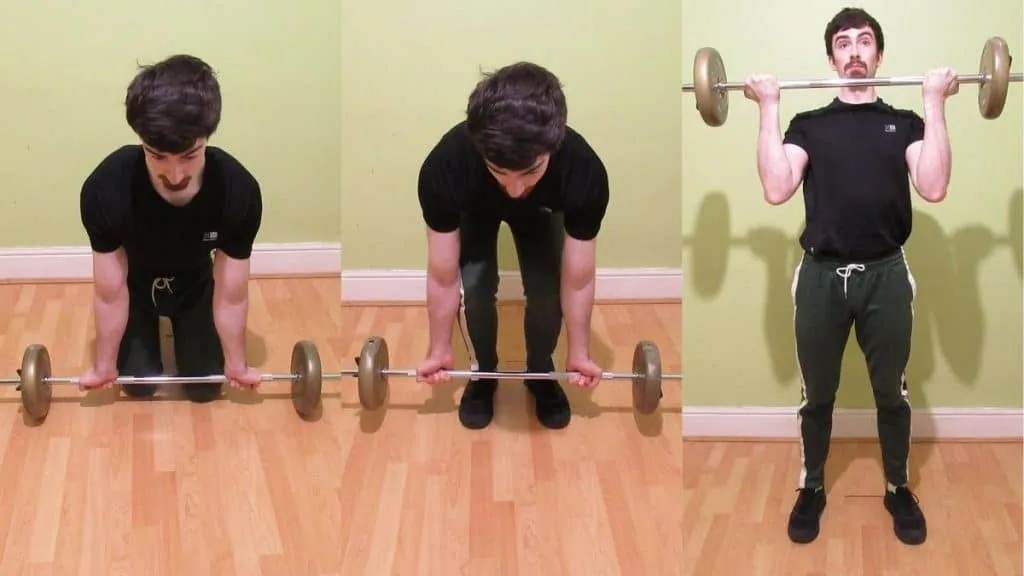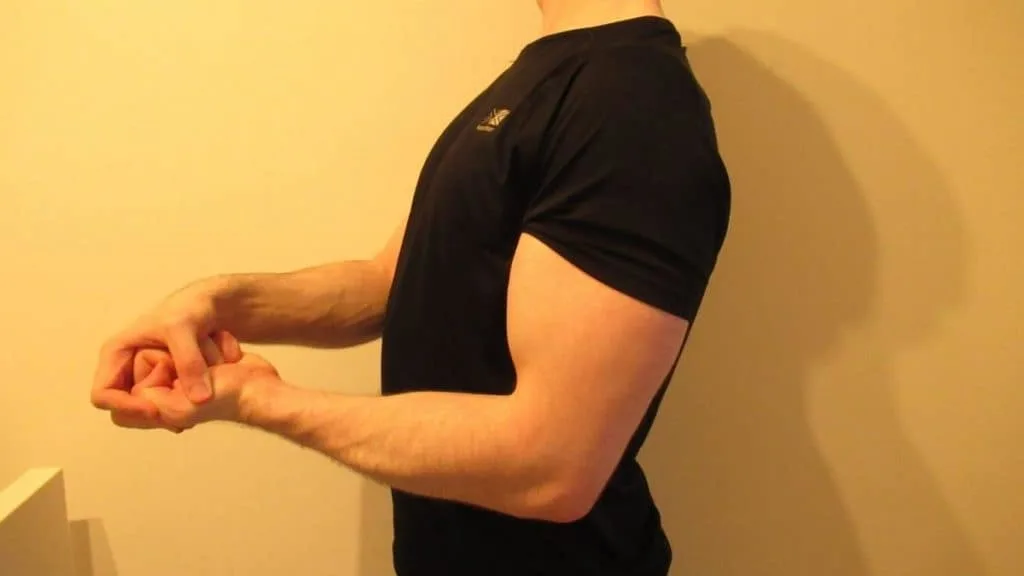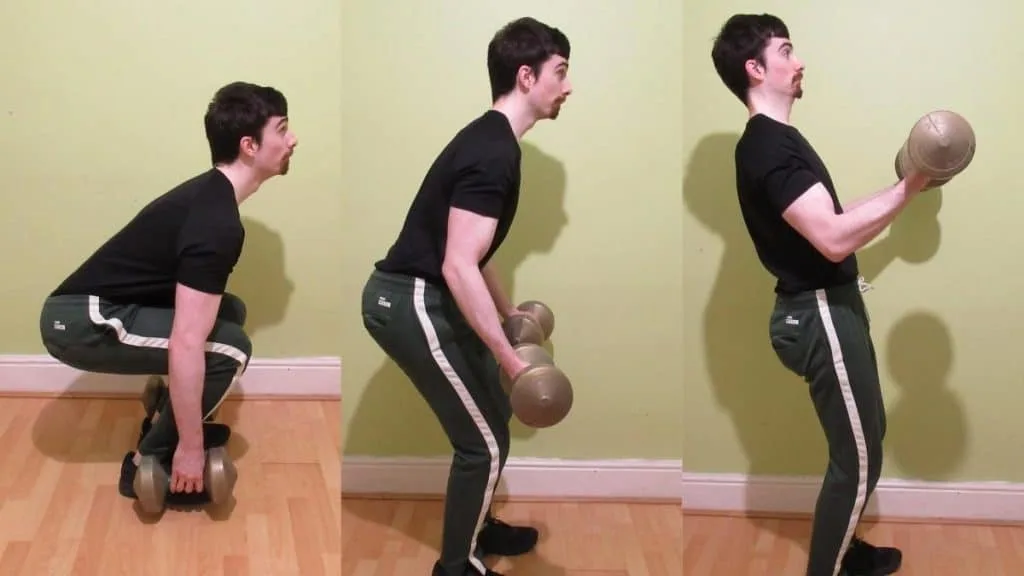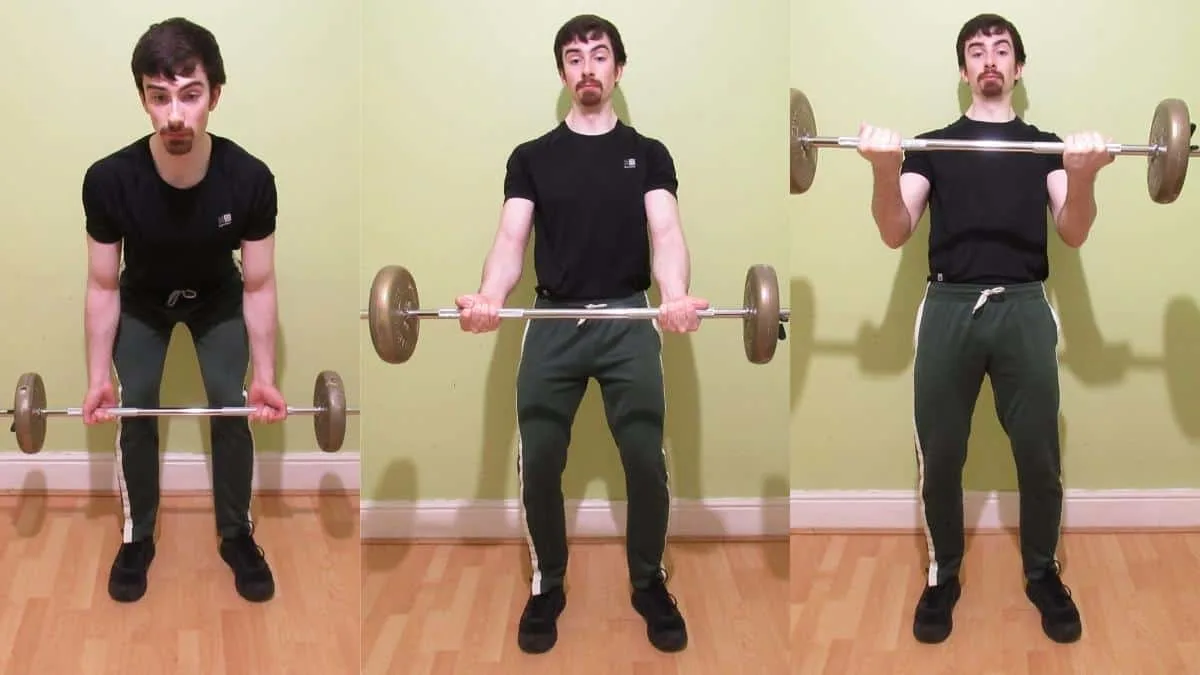Power curls work your biceps brachii as well as your posterior chain (glutes, hamstrings, spinal erectors). But most importantly, the power curl trains your explosiveness, an attribute that’s crucial for athletes such as wrestlers and football players to develop.
Power curls are a bit like the cheating barbell curl. The difference is that you do the former to increase your total body explosiveness, while bodybuilders typically perform the latter to improve the size of their biceps.
Power curl exercise details
- Main Muscles: Biceps brachii, glutes, hamstrings, erector spinae
- Secondary Muscles: Forearms, brachialis, abs, traps, lats
- Exercise Type: Strength
- Exercise Mechanics: Compound
- Difficulty Level: Intermediate
- Equipment Needed: Barbell, weight plates
How to perform power curls
- Load some weight onto a barbell.
- Stand behind the bar and grab it with an underhand grip just outside shoulder-width.
- Deadlift the bar off the floor.
- As the bar comes above your knees, thrust your hips forward and fling the bar up to the top position of a curl. Most of the power should come from your hips and legs.
- Very briefly contract your biceps.
- Reverse the motion and lower the bar back down to just below knee height.
- Repeat for 3-5 sets of 4-8 reps.
You can also opt to completely reset the bar after every rep. This may help you to use better technique (at least initially), but the initial phase of the movement—the deadlift part—is so easy that there’s little point in repeating it for the purpose of developing explosive strength. The magic of this movement begins to show itself once you lift the bar above your knees.
Similarly, if you want to focus more on your biceps, then you can just lower the bar slightly below hip height before thrusting it back up.
Power curl pros and cons
The barbell power curl is, in general, a faultless exercise for increasing your explosiveness. But if you’re a bodybuilder hoping that power curls will beef up your biceps, then you might be left disappointed.
Pro: Increases your explosiveness

Almost every type of athlete needs to be explosive to excel at their chosen sport. One of the best ways to improve this critical attribute is to simply lift weights in an explosive manner. Rather than performing slow and controlled reps to make your muscles burn, you should move the weight as quickly as possible.
To be clear, you should still remain in control of the bar. But there’s no need to lower the weight for a predetermined amount of time. Just do your rep as fast as you can and then bring the bar back down.
Power curls increase the explosiveness of your biceps and posterior chain by training the fast-twitch muscle fibers. So if your chosen sport or activity requires rapid movement of the limbs, then it’s definitely worth including the power curl in your training program.
The trick is to perform one continuous, fluid motion. Don’t deadlift the bar and then curl it; thrust your hips to move the bar straight into the top of a curl. Your biceps are performing a brief contraction merely because the exercise has an elbow flexion component to it.
Pro: Trains triple extension

It’s all well and good doing isolation exercises in an explosive fashion to focus on the fast twitch muscle fibers. But unless you have a lagging muscle group that needs special attention, what purpose do these exercises serve for improving your athletic performance?
You don’t run with just your hamstrings. No, you use your quads, calves, glutes, abs, and hamstrings. And that’s not even counting the secondary upper body muscles.
The point is that power curls are great because you’re generating maximum force by simultaneously extending your hips, knees, and ankles to more bar. This action has much more carryover to sporting performance than single-joint exercises.
With the power curl, in particular, you can actually remove the ankle component if you want to focus more on developing hip and bicep strength. While involving many muscles in a movement is definitely a good thing, sometimes it also makes sense to make the exercise a bit more specialized to hone in on specific areas and make them more explosive.
Con: Suboptimal for hypertrophy

This movement may well have the word curl in its name, but let me tell you, it’s far from a hypertrophy exercise. Remember, the biceps are only contracting for a brief second after you fling the bar up with your hips and legs, so they’re not doing much work.
Do something like 21s curls if you want to sculpt your guns because they provide way more time under tension for the biceps.
Of course, you can also do both types of exercises. Adding size via hypertrophy training is necessary for some athletes, especially those who have a harder time gaining muscle.
Likewise, training explosively as a bodybuilder or strength athlete can make you stronger and encourage you to use the fast-twitch muscle fibers, which are the fibers that have the largest growth and strength potential.
Variation: Dumbbell power curl

The dumbbell power curl requires more stabilization than the barbell version because now you have to focus on moving two weights rather than just one. As such, it’s ideal for improving your coordination, but it’s suboptimal for developing your explosiveness because you’ll need to lift lighter due to the complexity of the exercise.
The technique is almost the same as it is for the barbell power curl. However, it’s recommended to hold the dumbbells by your sides with a neutral grip instead of in front of you with a supinated grip.
This is so that the weights don’t drift too far away from your body.
When you lift the dumbbells in the initial phase of the rep, they should be almost touching the sides of your legs. Then, perform the usual thrusting motion to move the weights into the curl position. This time, however, you’ll be catching the dumbbells with a neutral grip at the top of the rep.
Related Exercise: Dumbbell supinated curl
Conclusion: Should you do power curls or not?
Any athlete or weight lifter who wants to improve their explosiveness will benefit from doing the barbell power curl. It strengthens your biceps while encouraging you to make use of the major muscle groups in your body to move the weight efficiently.
While power curls alone are unlikely to improve the size of your biceps in any noticeable way, they’re still useful within a muscle-building program because they encourage you to lift explosively. This, in turn, will help you to lift heavier weights and thus overload your arms with more resistance.
References
- Quinn, E. (2019, August 31). How to Use Explosive Training to Improve Sports Performance. Verywell Fit. https://www.verywellfit.com/explosive-power-training-3120713
- Lebo, B. (2013, September 12). Get Faster and Play Harder with Triple Extension Exercises. STACK. https://www.stack.com/a/triple-extension-exercises

